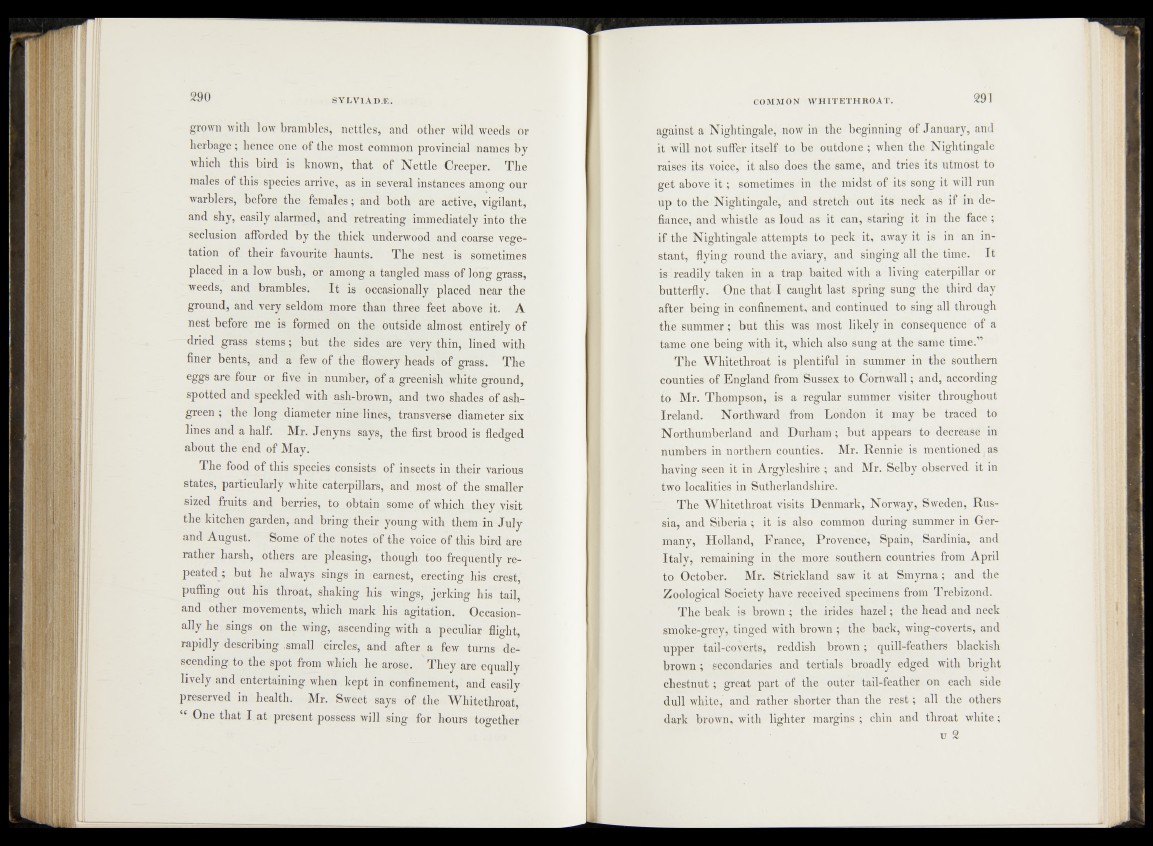
grown with low brambles, nettles, and other wild weeds or
herbage; hence one of the most common provincial names by
which this bird is known, that of Nettle Creeper. The
males of this species arrive, as in several instances among our
warblers, before the females; and both are active, vigilant,
and shy, easily alarmed, and retreating immediately into the
seclusion afforded by the thick underwood and coarse veere-
tation of their favourite haunts. The nest is sometimes
placed in a low bush, or among a tangled mass of long grass,
weeds, and brambles. It is occasionally placed near the
ground, and very seldom more than three feet above it. A
nest before me is formed on the outside almost entirely of
dried grass stems; but the sides are very thin, lined with
finer bents, and a few of the flowery heads of grass. The
eggs are four or five in number, of a greenish white ground,
spotted and speckled with ash-brown, and two shades of ash-
green ; the long diameter nine lines, transverse diameter six
lines and a half. Mr. Jenyns says, the first brood is fledged
about the end of May.
The food of this species consists of insects in their various
states, particularly white caterpillars, and most of the smaller
sized fruits and berries, to obtain some of which they visit
the kitchen garden, and bring their young with them in July
and August. Some of the notes of the voice of this bird are
rather harsh, others are pleasing, though too frequently repeated;
but he always sings in earnest, erecting his crest,
puffing out his throat, shaking his wings, jerking his tail,
and other movements, which mark his agitation. Occasionally
he sings on the wing, ascending with a peculiar flight,
rapidly describing .small circles, and after a few turns descending
to the spot from which he arose. They are equally
lively and entertaining when kept in confinement, and easily
preserved in health. Mr. Sweet says of the Whitethroat,
“ One that I at present possess will sing for hours together
against a Nightingale, now in the beginning of January, and
it will not suffer itself to be outdone ; when the Nightingale
raises its voice, it also does the same, and tries its utmost to
get above i t ; sometimes in the midst of its song it will run
up to the Nightingale, and stretch out its neck as if in defiance,
and whistle as loud as it can, staring it in the face ;
if the Nightingale attempts to peck it, away it is in an instant,
flying round the aviary, and singing all the time. It
is readily taken in a trap baited with a living caterpillar or
butterfly. One that I caught last spring sung the third day
after being in confinement, and continued to sing all through
the summer; but this was most likely in consequence of a
tame one being with it, which also sung at the same time.”
The Whitethroat is plentiful in summer in the southern
counties of England from Sussex to Cornwall; and, according
to Mr. Thompson, is a regular summer visiter throughout
Ireland. Northward from London it may be traced to
Northumberland and Durham; but appears to decrease in
numbers in northern counties. Mr. Rennie is mentioned as
having seen it in Argyleshire ; and Mr. Selby observed it in
two localities in Sutherlandshire.
The Whitethroat visits Denmark, Norway, Sweden, Russia,
and Siberia ; it is also common during summer in Germany,
Holland, France, Provence, Spain, Sardinia, and
Italy, remaining in the more southern countries from April
to October. Mr. Strickland saw it at Smyrna; and the
Zoological Society have received specimens from Trebizond.
The beak is brown ; the irides hazel; the head and neck
smoke-grey, tinged with brown ; the back, wing-coverts, and
upper tail-coverts, reddish brown ; quill-feathers blackish
brown ; secondaries and tertials broadly edged with bright
chestnut; great part of the outer tail-feather on each side
dull white, and rather shorter than the re s t; all the others
dark brown, with lighter margins ; chin and throat white;
u 2